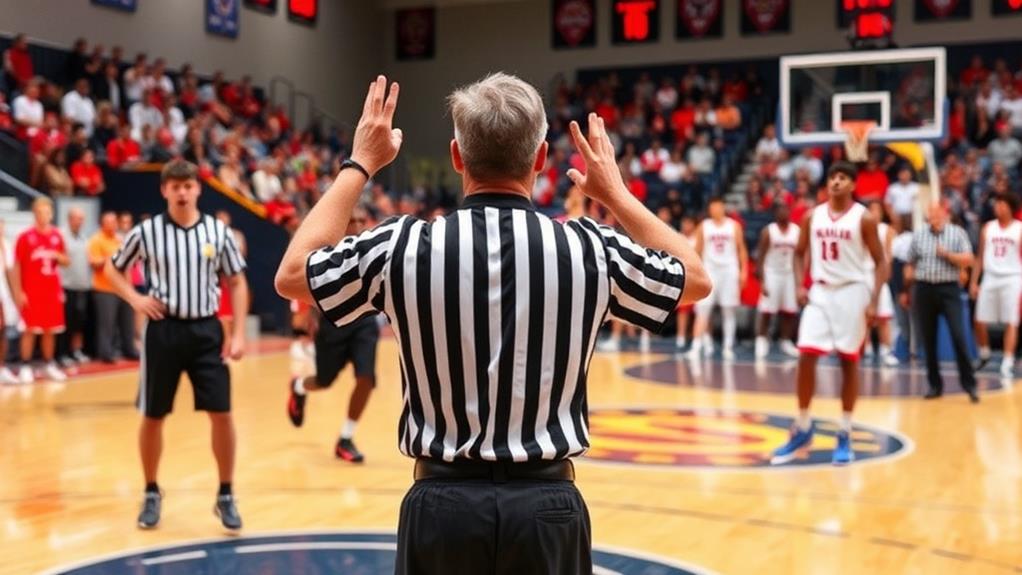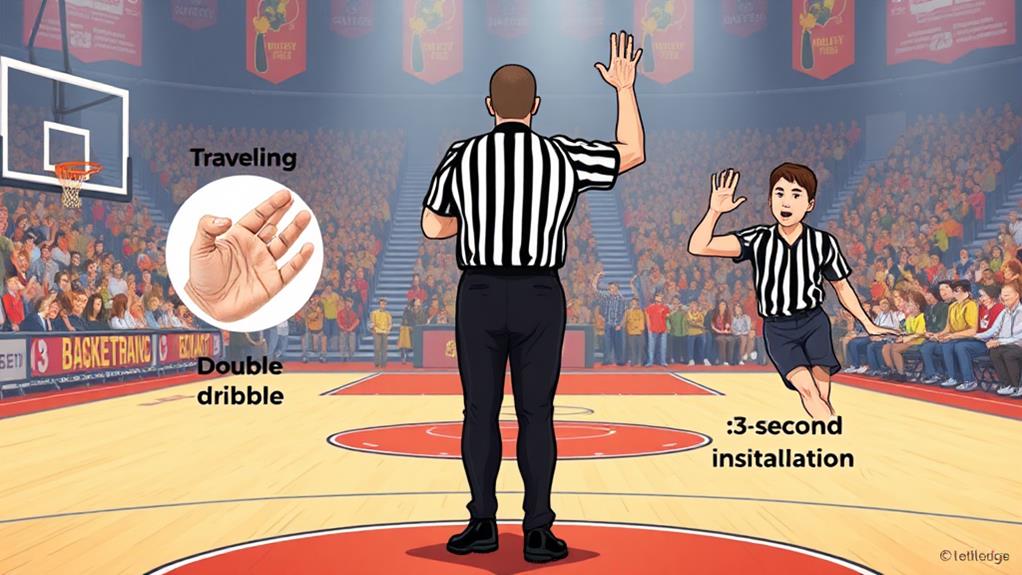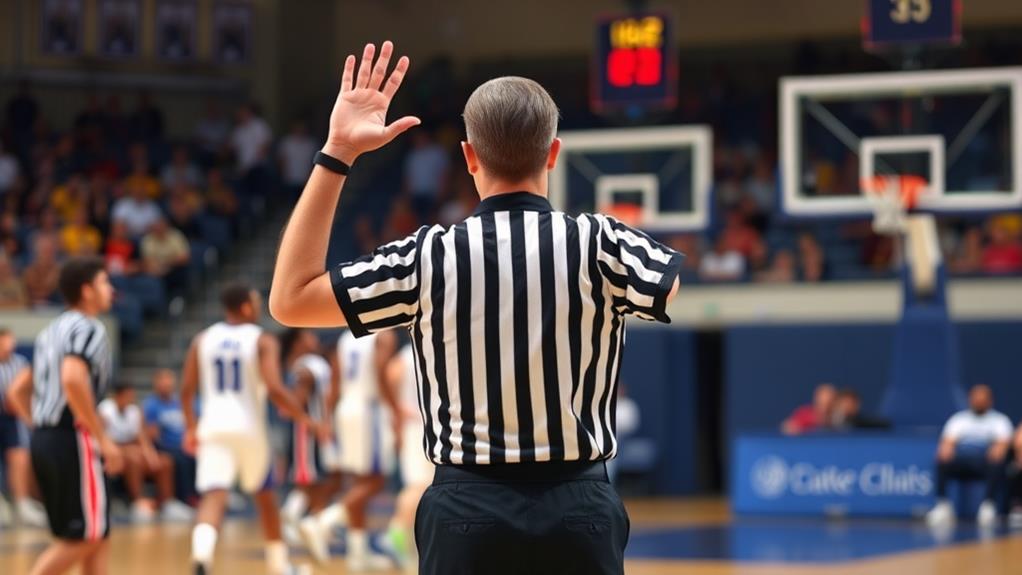
Common Basketball Referee Signals and What They Mean
September 24, 2024Understanding common basketball referee signals is essential for everyone involved in the game. A personal foul is indicated by raising one hand with fingers extended. For a charging foul, referees make a fist and punch it into their open palm. If there's a traveling violation, you'll see a circular motion with arms. Time-outs are signaled with a "T" shape using both hands. These signals help maintain order and keep everyone informed about game dynamics. If you want to know more about other signals and their meanings, there's plenty more to discover.
Overview of Referee Signals
Referee signals play an essential role in basketball, with each one designed to convey specific information about fouls, violations, and game status. These basketball referee hand signals guarantee that players, coaches, and spectators understand the officiating decisions clearly. Each signal has a universally recognized meaning, which contributes to effective communication throughout the game.
The urgency created by the shot clock impacts not only gameplay but also how referees signal infractions, as quick decisions need to be made on both ends. As teams push for efficiency, referees must maintain clarity in their signaling to avoid confusion during fast-paced moments, especially when it comes to offensive strategy and decision-making.
When a foul occurs, the referee signals it promptly, letting everyone know that a player commits an infraction. This can include intentional fouls or more severe technical fouls, each with its own distinct signal. Consistency in these signals is essential for maintaining order and flow during the game. If a violation occurs, the referee's clear communication helps everyone stay informed about the game's progression.
While referee signals may vary slightly in different leagues, the core meanings remain largely the same. This consistency is critical, as it promotes fairness and understanding among all participants. Referees undergo extensive training and observation to master these signals, guaranteeing they're effective in their communication during games.
Common Fouls and Signals
Understanding common fouls and their corresponding signals is essential for players, coaches, and fans alike. Recognizing these signals helps everyone grasp the flow of the basketball game. The referee uses specific gestures to indicate different fouls, ensuring clarity on the court.
Just like in soccer, where field dimensions and equipment requirements play a vital role, understanding the rules of basketball enhances the overall experience for participants and spectators.
A personal foul is signaled by raising one hand with fingers extended, indicating illegal physical contact. When a charging foul occurs, the referee makes a fist and punches it into the open palm, signaling that the offensive player has violated the defender's legal position.
If a blocking foul happens, you'll see both hands placed on the hips, representing illegal defensive positioning.
Technical fouls are more serious and are shown by forming a "T" shape with the arms, indicating unsportsmanlike conduct by players or coaches. Finally, an intentional foul is represented by crossing both arms in an X shape, highlighting a deliberate foul with malicious intent.
Understanding these signals not only improves your game knowledge but also enhances the overall experience of watching basketball. Keep an eye out for these signals next time you're at a game!
Violations and Their Signals

In basketball, recognizing violations and their corresponding signals is essential for anyone involved in the game, especially for referees and players alike. Understanding these signals can enhance your game knowledge and contribute to a more enjoyable experience for everyone on the court.
Here are some key violations and their signals you should know:
- Traveling: The referee makes a circular motion with their arms in front of their face, indicating illegal movement of a player's feet.
- Double Dribble: The referee holds their hands in front, palms down, alternating them up and down to show repeated dribbling.
- Carrying: The referee flips one hand from palm up to palm down multiple times, signaling a violation during dribbling.
- 3-Second Violation: The referee raises three fingers pointed down while swiping their hand back and forth, indicating a player has stayed in the paint too long.
Additionally, an 8-second violation is indicated by the referee raising eight fingers when the offensive team fails to advance the ball across half-court in the allotted time.
Knowing these referee signals can help you avoid violations and keep the game flowing smoothly, making it easier to focus on improving your skills, such as those outlined in soccer moves.
Game Management Signals
Recognizing game management signals is just as important as identifying violations on the court. These signals help referees communicate important information during stoppages in play, ensuring clarity for players, coaches, and spectators. The significance of these signals aligns with the YMCA's emphasis on holistic development, where clear communication fosters teamwork and respect among players.
One key signal is the time-out signal, where referees form a "T" with both hands, indicating a break in the action.
Another essential signal is the substitution signal, represented by crossing the arms in an "X." This allows for player exchanges during dead ball situations and keeps the game flowing smoothly. When it's time to resume play, referees raise their hand until the game clock starts again, ensuring the timekeeper is aware.
The jump ball signal, shown by raising both hands above the head with fists, determines possession at the start of the game or after a tie-up. If a team fails to comply with the timing rules, referees use the delay of game signal, extending one hand in front of the body with the palm up.
Understanding these game management signals is crucial for all involved to maintain order and flow throughout the game.
Special Circumstances and Signals

Communication is essential during special circumstances in a basketball game, and referees employ specific signals to convey vital information. These signals help maintain the flow of the game while guaranteeing player safety and fair play.
As the game evolves, effective communication also plays a vital role in defensive strategies, reflecting the need for teamwork on the court, particularly when responding to historical shifts in defensive approaches.
- Instant Replay Review: When a play needs reassessment, referees form both hands into a rectangle, signaling the need for an instant replay review.
- Technical Foul on Coach: If a coach displays unsportsmanlike conduct, referees point one hand toward the coach's box, emphasizing the technical foul.
- Ejection Signal: When a player must leave the game, the referee makes an ejection signal by extending one arm downward with a fist.
- Injury Timeout: To halt play for a player's injury, referees make a waving motion above their head, indicating an injury timeout.
These referee signals are vital when a foul occurs or a player attempts to argue a call. By using clear hand signals, referees make it easier for players, coaches, and fans to understand the game's dynamics.
Mastering these signals enhances communication and guarantees the game runs smoothly.
Conclusion
Now that you're fluent in referee signals, you can impress your friends—just don't confuse a traveling call with a request for a snack. Remember, every wave, point, and whistle has a purpose, even if you think the ref is just practicing for a future career in interpretive dance. Next time you're at a game, channel your inner referee and keep those signals handy; you never know when a foul might lead to a snack break!


